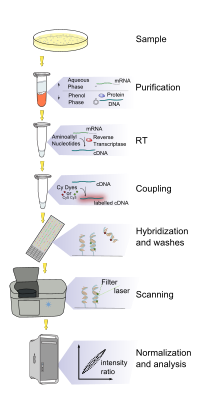Options for minimal residual disease detection
Minimal residual disease[edit | edit source]
It is a subclinical level of cancer, when malignant cells are no longer detected by conventional cytological methods during therapy. The patient is in complete clinical remission, but up to 1010 malignant cells may be present in his organism. Finding them is associated with a poor prognosis for the patient, mostly related to relapse of the disease. Their detection is also important for the further course of therapy.
Detection[edit | edit source]
Minimal residual disease is primarily detected in hematologic malignancies, but is now being tested in solid tumors. The principle of its monitoring is to find such a sign on a tumor cell that will carry the entire clone and will differ from healthy cells. In the past, qualitative and semi-quantitative methods were used, but today more quantitative methods are being developed, which make it possible to monitor any increase or decrease in the tumor population. Currently, several methodological approaches are used, which differ in their specificity, sensitivity, cost, etc. The most sensitive method is RT-PCR in real time. mRNA is the desired characteristic of tumor cells. Tumor cells differ from normal cells in their expression profile – they express other genes. Isolated tumor cells are detected in the blood, bone marrow and lymphatic system. Punctate sampling of bone marrow or peripheral blood collected in an anticoagulant (EDTA) is used. When using RT-PCR, it is possible to detect a cancer cell among 106-107 normal bone marrow cells.
An example of the use of specific malignancy markers in clinical practice:
- Chronic myeloid leukemia: transposition of the ABL gene from chromosome 9 to the BCR gene on chromosome 22  ;→ chimeric gene BCR-ABL → protein p210 (persistent positivity in patients at risk of relapse).
- Acute myeloid leukemia: translocation of chromosome t(15;17) → expression of the fusion gene PML-RAR-α (residual marker diseases).
Markers of Minimal Residual Disease
Links[edit | edit source]
Source[edit | edit source]
External links[edit | edit source]
References[edit | edit source]
- MASOPUST, Jaroslav. Selected chapters from the pathobiochemistry of organs. 1. edition. Karolinum, 1997. 175 pp. pp. 89-90. ISBN 80-7184-415-2.

